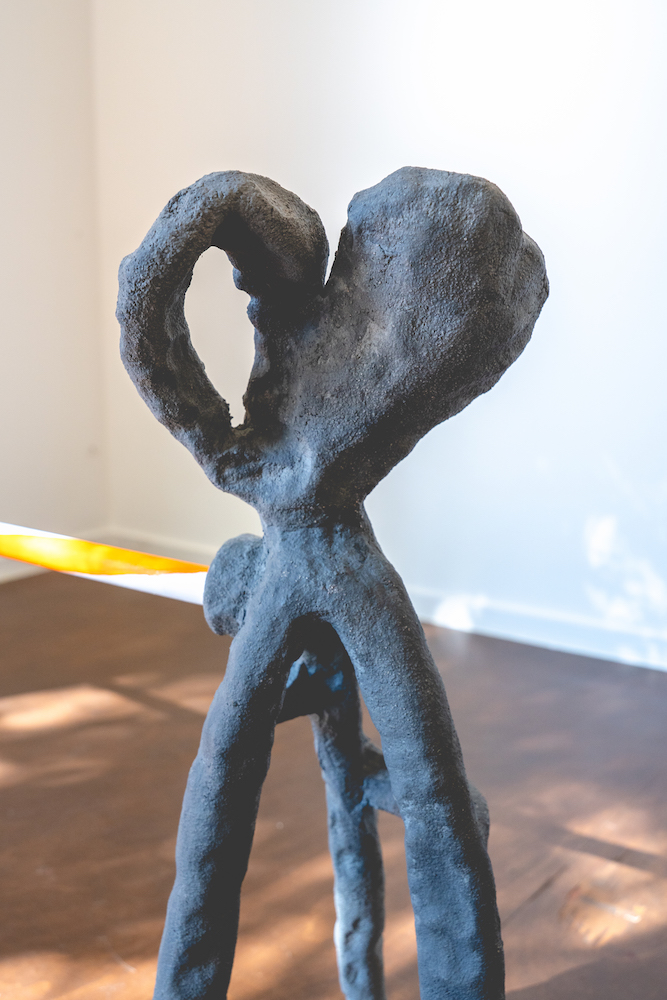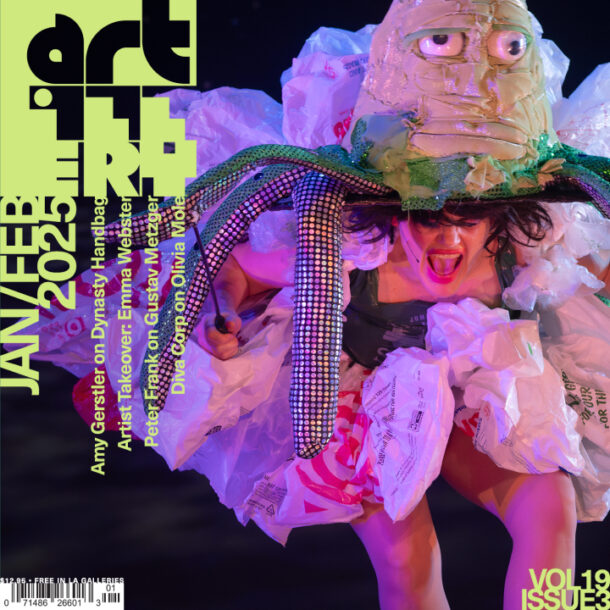In a backyard in Glendale, Marina Weiner’s solo exhibition, “Stripe Machine,” cleverly redefines the term “public art.” The art is not shown in public; the gallery, Hermitage Los Angeles, is a small, beautifully built shed behind a private home. Rather, Weiner’s ceramic sculptures take inspiration from public municipal infrastructure, “accidental sculptures” in the artist’s words. Sawhorses, chain-link fences, and traffic signs are all affectionately gestured at even as Weiner takes these forms in much more spirited directions. Even still, there is latent functionality in the works, as if they have a utility that has yet to be uncovered. The sculptures are machines but what they do remains unclear – we can assume something related to stripes. All jokes aside, the implied usefulness of the sculptures does not undercut their artistic value. Instead,it invites us to look anew at the well-worn public works that inspired the sculptures.
Despite the shared language of public works, Weiner’s sculptures do not resemble more austere, municipally-coded sculptures like Cady Noland’s toppled chainlink fence, Institutional Field, or Cameron Rowland’s installation work, Insurance, composed of crossed cargo container lashings. Noland and Rowland have both brought found urban forms directly into the gallery to critique the political assemblages the objects are a part of directly. Instead, the sculptures here seem more in conversation with artists like Rachel Harrison and Peter Fischli. Like Harrison’s If I Did It sculptures or Fischli’s traffic lights, Weiner uses found city objects as a jumping off point towards forms that resemble their inspiration but tend toward something more comical.

Marina Weiner, Intake Manifold, 2025. Photo: Simon Kline. Courtesy of The Hermitage.
Four ceramic sculptures, entitled Sentinels (2025), are composed of wood orange and white striped poles connected on either side by two- or three-legged ceramic bases. The design and safety orange recall sawhorses used to demarcate construction sites, crime scenes, and road closures. Despite the exhibition’s invocation of machines and the sculptures’ resemblance to sawhorses, they are decidedly more playful. The bases of each Sentinel have floppy, rabbit-like ears, giving them a cartoonish quality. More importantly though, the ears disrupt any clean division between the biological and the mechanical. In other words, living creatures do not operate the machinery, they are a part of it.
This is likewise true of Intake Manifold (2025), a concrete gray, braided ceramic sculpture creeping like ivy down the gallery’s back wall. At each knot, one of the strands points out perpendicularly towards the viewer, revealing itself to be a hollow tube reminiscent of a candle stick or an exhaust pipe. Here too, the work appears to be both machine and living organism.
Compressor (2025) stands out from the other sculptures in the show for its mass. At eighteen inches tall, the work stands only slightly above the Sentinels’ perky ears but because it is a grey rectangular slab, the work appears more imposing. A round hole is drilled through the sculpture’s upper left corner. A ridged wheel, like the edge of a quarter or the spark wheel on a lighter protrudes from the side. The sculpture looks somewhat like a lighter or a smartphone but the nature of working with clay limits this comparison. Unlike the smooth surfaces of plastic or glass, Compressor’s rough texture is evidence that it was made by hand.

Marina Weiner, Sentinels with Stripes, Daylight (detail), 2025. Photo: Simon Kline. Courtesy of The Hermitage.
Channelizer No. 3 (2024) is the exhibition’s only work on paper. At the center, a series of orange rhombuses form a semi-circle that trails off into the upper right corner. Though the painting is abstract, Weiner’s interest in municipal infrastructure destabilizes the certainty of this assertion. Once again, we are in a gray area between two seemingly clear poles. This time, the familiar divide of abstraction and representation. After all, are road signs any less abstract than this painting? One could respond that traffic signs acquire representative meaning via their use—two arrows converging means merge, a diamond signifies carpool lane—but this only strengthens the earlier point. Weiner’s work contains a latent functionality, one that simply hasn’t been put to the test yet.
For the opening, Weiner prepared small zines featuring photos of traffic cones, concrete barricades, and other recognizable yet overlooked objects of urban life. The images make explicitly clear the relationship between the works in the show and the depicted objects. However, the details I mentioned before—the latent functionality, the binding of biology and machinery, the traces of the artist’s hand—reveal a notable absence in the zines: people. In turn, this omission emphasizes the human touch in Weiner’s artworks.


